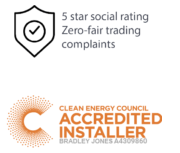Curious about going solar?
Chat to one of our experts
- Discover tailored solutions to reduce your energy bills and boost home value with our solar experts.
- Receive personalised advice to maximise your savings and sustainability.
- Understand the potential of solar for your home, making the switch easy and profitable.



Here's What You Can Expect From The Call
- Custom advice tailored to your home's energy needs.
- Clarity about potential savings on your energy bills.
- Comprehensive understanding of our Inflation Protection Plan.
- Detailed explanation of the solar installation process.
- Answers to all your queries about solar energy.
Who is This Call Fit For?
- Homeowners looking to reduce their energy bills.
- Those seeking sustainable solutions for their energy needs.
- Individuals keen on increasing their property value.
- Anyone interested in understanding the benefits of solar power.
- Families wishing to secure long-term savings with solar.

What Our Clients Say
"A very good experience overall
"After researching solar for my home and obtaining several prices,
"Lamora visited and explained in simple terms
Ready to Speak With One of Our Experts?
Frequently Asked Questions
What is the cost of installing a residential solar system?
The cost of installing a residential solar system in Australia depends on system size, panel and inverter type, location, installation complexity, and additional components. A 5 kW system, for example, after government incentives, might range from AUD 5,000 to AUD 10,000 or more.
Contacting us is the best way to get an accurate no-obligation quote, considering that prices vary based on state, market conditions and government policies.
What government incentives or rebates are available for installing solar panels?
In Australia, government incentives and rebates for solar panel installations primarily include Small-scale Technology Certificates (STCs) that can be traded to offset installation costs, Feed-in Tariffs (FiTs) that compensate solar system owners for excess electricity fed back into the grid, and various state-specific rebates and incentives.
The availability and details of these incentives can vary by location and may change over time. To get the most current information and guidance on available incentives, homeowners should consult their local government websites and book a call with us for a personalised solar assemment.
How much can I expect to save on my electricity bill with solar power?
The savings on your electricity bill with solar power depend on factors like the size of your system, your energy consumption, local sunlight availability, electricity rates, and potential feed-in tariffs. A larger system tailored to your consumption habits can result in greater savings, especially if you use most of your electricity during daylight hours. Solar power can offer long-term financial benefits and reduce your carbon footprint, but it’s important to undertake a personalised assessment based on your situation.
What is the expected lifespan of solar panels, and what kind of warranty is provided?
Quality solar panels typically have a lifespan of 25 to 30 years, with many continuing to function efficiently beyond that period. Manufacturers provide two main warranties: a performance warranty that guarantees a certain percentage of the original power output and a product warranty covering defects.
It’s important to select reputable manufacturers and installers to ensure you receive reliable warranties and maximise the longevity and performance of your solar panels.
How much maintenance does a solar system require?
Solar power systems require minimal maintenance, making them a low-maintenance renewable energy option. Basic maintenance includes occasional cleaning to remove debris and visual inspections for damage. Additionally, monitoring the system’s performance and addressing shading issues can help ensure optimal efficiency, while professional inspections every few years can provide added peace of mind regarding its functionality.
Can I sell excess electricity back to the grid, and if so, how much can I expect to earn?
In Australia, you can sell excess electricity generated by your solar panels back to the grid through a feed-in tariff (FiT) program. The earnings from selling excess electricity depend on your location within Australia, the specific FiT scheme in your area (gross or net FiT), the FiT rate set by your state or provider, your solar system’s size, and whether your area has time-of-use tariffs. To determine your potential earnings, contact your local utility or energy authority to understand your specific Australian location’s current FiT rates and program details.
But remember, the savings from installing solar are predominantly made from the power you don’t pull from the grid rather than the power you sell back to it. For example, if a kW costs $0.39, but the FiT is only $0.08 then it’s much better for your wallet to save $0.39 than it is to earn $0.08 in credits.
